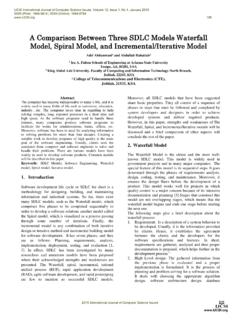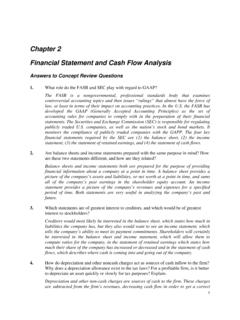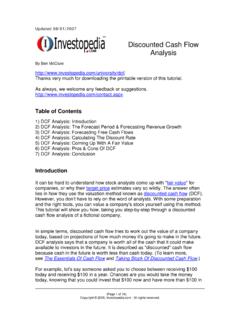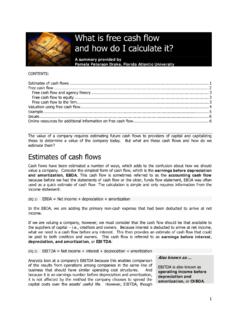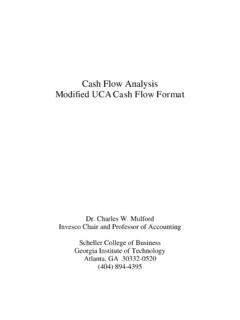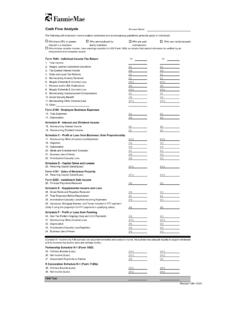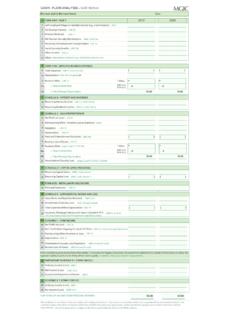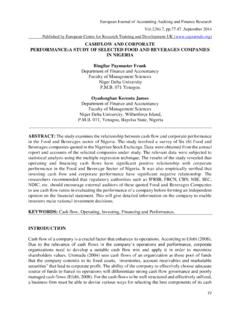Transcription of RISK FACTORS IN CONSTRUCTION PROJECTS CASH-FLOW …
1 RISK FACTORS IN CONSTRUCTION PROJECTS CASH-FLOW analysis Mohamed Abd El razek1, Hosam El Din Hosny2 and Ahmed El Beheri3 1 CONSTRUCTION and Building Department, Arab academy for science and technology,Cairo Branch Cairo, Egypt 2 Constructionand Engineering Department, Zagazig University Zagazig, Egypt 3 CONSTRUCTION and Building Department, Arab academy for science and technology, Cairo Branch Cairo, Egypt Abstract This study presents a new methodology for net cash flow prediction. This methodology depends on applying risk FACTORS that affect the cash flow process. The probabilistic S curves are used as an alternative of the Standard S curve and the traditional method that neglect the effect of risk and uncertainties. These risk FACTORS have been determined through a questionnaire survey. This survey was conducted among the main three parties in CONSTRUCTION industry contractors, consultants and owners.
2 Two hundreds questionnaires were sent to these organization, only 60 responses were received within the accepted range of questionnaire response from 20-30%. Through this survey, the most important cash flow risk FACTORS were clearly identified. A simulation programs were used for generating the probabilistic S curves. A MS excel macro was used for a probabilistic cash in prediction. Probabilistic S curves provide a probability distribution of required cost and time to finish the project for any selected point at the project . The probabilistic cash flow prediction enables the users to accurately determine the project cash flow position. Keywords: Cash flow - risk FACTORS - probabilistic analysis CONSTRUCTION management 1. Introduction Financial Management has long been recognized as an important tool in CONSTRUCTION industry.
3 However, the CONSTRUCTION industry suffers the largest rate of insolvency of any sector of the economy. Companies fail because of poor financial management, especially inadequate attention to cash flow forecasting. It is common consensus that cash flow management and liquidity are key elements in the survival of contractor [23]. Therefore, many companies forecast and project expenditures to manage their finances. Uncertainty in information affects decision making. For example, in structured finance transactions, the different counterparties involved perceive risks with differing levels of comfort. For many risk FACTORS in such transactions, such as legal and regulatory risks , historical and numerical records are missing so that actuarial approaches fall short in resembling and modeling transaction-specific risks .
4 Information on such risks is often vague, subjective, and uncertain. However, a confined number of experts that have intimate knowledge and some opinion on these risk FACTORS may exist [29]. The uncertainty and ambiguity are caused not only by project -related problems but also by the economic and technological FACTORS . Heretofore it has been indicated the serious importance of the CASH-FLOW prediction for CONSTRUCTION contractors. A reliable CASH-FLOW prediction can help to accurately identify the expected project financial requirement. So that, decision can be made at a suitable time regarding the potential sources of this CONSTRUCTION project CASH-FLOW is mainly affected by many uncertain but predictable FACTORS . Through the literature survey, it was noticed that the majority CASH-FLOW prediction models have been based on standard cash flow S-curves, IJCSI International Journal of Computer Science Issues, Vol.
5 11, Issue 1, No 2, January 2014 ISSN (Print): 1694-0814 | ISSN (Online): 1694-0784 Copyright (c) 2014 International Journal of Computer Science Issues. All Rights Reserved. developed using the traditional manual approach, mathematical and statistical models. Many of these models failed to consider and analyses the risk FACTORS such as changes in the design or specifications, contract conditions pertaining to cash in flow, interim valuations and certificates and CONSTRUCTION programming issues such as inclement weather responsible for the considerable variations in the modeled cash flow profiles. Hence, it is safe to say that a reliable CASH-FLOW prediction should take into consideration the effect of these risk FACTORS . This was demonstrated by the development of a series of typical S-curves by many researchers [18].
6 Kaka and Price [18] in developing a model for cash flow forecasting identified other risk FACTORS affecting cash flow profiles to include estimating error, tendering strategies, and cost and duration variances. The identified risk FACTORS have been reported to affect cash flow profiles as well as significantly impacting on the modeling of cash flow. However the perception of the contractors to the likelihood of the risk FACTORS occurring in different project types and of varying scope and duration is yet to be investigated. 2. Research scope and Objective The objective of this paper is the development of a probabilistic net cash flow model with the effect of the risk FACTORS among the CONSTRUCTION industry. At first a questionnaire survey was distributed among the CONSTRUCTION industry to determine the most important risk FACTORS with their impact and frequency.
7 Then the second stage is to implement the risk FACTORS in the designed model which consist of three stages as illustrated in Fig 1 First stage planning and scheduling using primavera p6 (commercial software), second stage is the implementation of the most important risk FACTORS through the tested project , this stage was done by primavera risk analysis ( commercial software ) and the outcome is the probabilistic cash out. The last stage is the modeling and the production of the probabilistic cash in, net cash flow and the finance cost. This stage was made through a designed Microsoft Excel macro sheet. The designed model was validated through a real project with the comparison of the model outcomes and the actual data. 3. A Review of Previous Cash Flow Models In the absence of an ideal net cash flow curve, previous researchers have used ideal value curves to produce net cash flow profiles.
8 The method defines the cash-in curve as the value curve minus any retention held, with an allowance for time lag. Similarly, the cost curve is derived from the earnings curve using specified lags and percentages of earnings. Planning & scheduling WBS Activities relationships and Duration Resource allocation Cash out Curve Implementation of Risk FACTORS to the resultant Cash out Building Risk register with risk FACTORS and their probability and impact Assigning risk register to the project Probabilistic Cash out Applying Excel macro sheet to get: Probabilistic Cash in Probabilistic net cash flow Cost of finance Risk model stages IJCSI International Journal of Computer Science Issues, Vol. 11, Issue 1, No 2, January 2014 ISSN (Print): 1694-0814 | ISSN (Online): 1694-0784 Copyright (c) 2014 International Journal of Computer Science Issues.
9 All Rights Reserved. The possibility of building an ideal value curve based on historic data has been the subject of a considerable amount of research [9, 28, 10, 15]. Although these approaches have gained general acceptance, they have not been without criticism. Hardy [14] found that there was no close correlation between the figures given for 25 PROJECTS considered, even when the PROJECTS were similar. Oliver [ 25] analyzed PROJECTS collected from three CONSTRUCTION companies. He concluded that, although the number of PROJECTS analyzed was statistically small, CONSTRUCTION PROJECTS are individually unique and follow such diverse routes that value curves based on historical data are not capable of providing the accuracy required for individual contract control. Other researchers thought that value curves were unique to single contracts, and therefore should be estimated for each project .
10 Allsop [3] linked a cash flow model to an estimating program which already existed at Loughborough University of Technology. The program used the estimated cost and estimated value with the contract schedules to calculate the cash flow of the project . Studies on the accuracy of models based on ideal value curves are in conflict. The feasibility of building ideal value curves for different project types is questionable. There is evidence that single curves cannot be fitted accurately through even one type of project . Kenley [20] studied the variability of net cash flow profiles by collecting the cash-out and cash-in data from 26 commercial and industrial PROJECTS . The goodness of fit was reasonably accurate and 26 net cash flow profiles were produced. Comparisons between the results indicated that there was a wide degree of variation between the profiles of individual PROJECTS .


